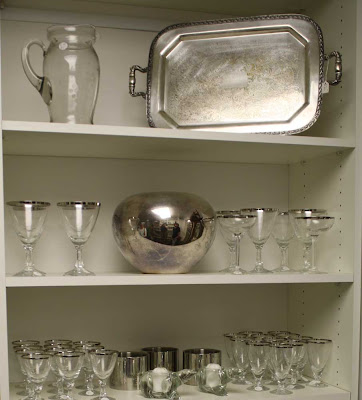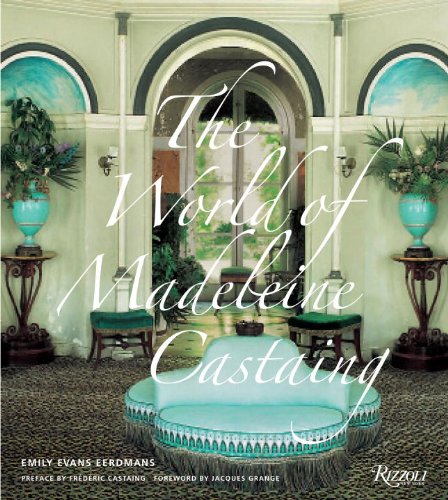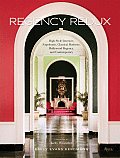I am over the moon to share this space with Bart Swindall, historian of Chicago's Auditorium Theater. (You may already be familiar with his always must-read comments under his
nom de web, Magnaverde.)
On my trip to Chicago this spring, Bart took me for a private tour of the Casino Club, which ranks with Dawnridge and the Brighton Pavilion as the most sublime interiors I've ever experienced. The still intact and jaw-dropping decoration was done by Rue Winterbotham Carpenter, of whom I was embarrassed to admit I had never heard. Bart has graciously agreed to enlighten all of us here.
From Bart:

I’ve called Rue Winterbotham Carpenter “Chicago’s Greatest Unknown Decorator." Of course, she’s not really unknown. In certain circles, her dynamic personality is still very much alive, almost eighty years after she died. The Chicago we know today might be a different city without her influence, and yet, even in the city where she spent most of her life, few people have ever heard of her.
One reason that Carpenter is virtually unknown is that, unlike Elsie de Wolfe & many of her decorating contemporaries, she never wrote any books & only a few brief articles & she didn't advertise. Most of her jobs were for friends, or friends of friends. But what friends she had! She was the best friend of Sara Murphy--of
the Murphys, the beautiful American couple who moved to France after WWI, virtually invented sun-bathing, put the French Riviera on the social map and transfixed Scott Fitzgerald with their beauty (at least until he hung them out to dry in one of his novels). Rue & her daughter Ginny goofed around in Venice with the Murphys & Cole Porter before Cole Porter became famous,
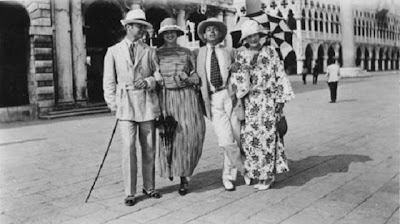
and other photos show them posing on the beach with the Murphys the year that Picasso was part of the gang. He sketched her, but didn’t paint her portrait, although many important artists of the period did, among them Sir John Lavery, who married another Chicago girl. A gigantic Rousseau jungle scene hung in Rue’s Chicago living room. With her husband, the composer John Alden Carpenter, Rue was also friends with some of the greatest musicians & poets of the early 20th Century. She knew Gertrude Stein & Igor Stravinsky.
Back at home in Chicago, she was the president of the Arts Club for more than a decade, in which position she almost singlehandedly brought Modern art to Chicago, inviting many of her artist pals to come to the city for a one-man show.
 The Arts Club of Chicago today which has kept many of Carpenter's furnishings to this day
The Arts Club of Chicago today which has kept many of Carpenter's furnishings to this day
So how does a woman like that vanish into thin air? Especially a woman someone whose work was so memorable, and so distinctively her own? Well, unlike the seemingly ageless Elsie de Wolfe, Rue Carpenter died fairly young, just as her work was beginning to attract national attention. Also, unlike de Wolfe, Carpenter seems to have had little interest in self-promotion. Famous artists may have painted her, but images of most of those portraits are hard to track down. Certainly there is a dearth of the kind of perfectly posed photos of Rue wearing the latest fashions, the way there are with de Wolfe. Also, unlike Elsie, Rue wrote no books, and only a single article was ever published under her name, entitled “Problems in Decoration” which appeared in the August 2, 1930 of
Vogue magazine. But even that one short article, it seems, reached sympathetic ears.
Almost 20 years later, long after Rue Carpenter’s death, her words were quoted in a lecture given at the Parson’s School of Design in New York, by none other than Billy Baldwin himself—who had never met her. She had powerful friends, even in death. Archibald MacLeish dedicated a poem to her.
Another reason for Carpenter’s relative obscurity is that few of her interiors survive, and of the few that do, not one is open to the public. Carpenter's truly public jobs–her friend &
Tribune critic Fanny Butcher's bookstore in the old Pullman Building & her gorgeous 1910 reimagining of Louis Sullivan's Auditorium Theatre–are long gone. Well, sort of. The Pullman building across from the Art Institute is really gone, torn down in the 195Os, but Rue's long-forgotten decorative scheme for the Auditorium was documented in 2000 (thanks to the careful work of historic paint analyst Robert A. Furhoff) as part of the Auditorium's ongoing restoration. Underneath the recent recreation of Louis Sullivan's original 1889 décor, Carpenter's striking scheme still exists, hidden below a century’s worth of later overpainting.
When the Auditorium opened in 1889, Sullivan’s ivory & gold décor was a revelation, but by 1910, when Chicago finally acquired its own resident opera company, the theatre was tired & dingy and the theatre management hired Rue Carpenter to revamp the place. And did she ever. The gorgeous palette she devised was perfect for the company’s inaugural performance of
Aida, with its orientalist decor. Under Carpenter’s direction, Sullivan's plaster reliefs & panels were glazed in glowing crimson & Pompeian red, lapis blue & viridian green, all highlighted with gold, and all of which jewel-like hues colors were set off with a Pompeian red velvet curtains & seats. Not only that, she had the entire ceiling of the theatre—by then a dirty beige—covered with aluminum leaf, lacquered to look like gold. Parisians had already seen–and loved–such violent color contrasts in the sets & costumes for Serge Diaghilev's
Ballets Russes the year before, but such brilliance in color was brand new to Chicago. The novelist Arthur Meeker said “For a season or two, we had an opera house worthy of the troupe that sang in it.”

In the late 1920s, Carpenter decorated the Fortnightly, Chicago’s oldest women’s club, having previously done the public rooms at the Racquet Club, then an all-male preserve. And, as president of the peripatetic Arts Club, she designed the interiors for its several homes over the years. Today, the Arts club is housed in a crisp Modernist space designed by John Vinci, but Rue’s beloved 19
th century furniture is still in place, and it looks as elegant as ever against a frankly modern background. In Chicago, she also decorated the Harvard-Yale-Princeton Club, the dressing rooms of the Palace Theatre and she did at least one hotel in Wisconsin, not to mention numerous private homes.
All these received lavish praise. But it was at the Casino—then, as now, Chicago’s most exclusive & prestigious club—that she did her most original, most beautiful work, and thanks to its careful preservation by the club’s membership, her work there still exudes its original drop-dead glamour & freshness.

In the Casino’s semicircular, black walled, vestibule, dim indirect light glows from a cove below a gold-leaf ceiling. In the elegantly-railed stair-hall, murals of black & white trees by the Russian artist Nikolai Remisoff decorate the walls. In the curving, black-walled salon are simple white marble chimneypieces in Directoire style, and cozy groupings of Directoire
meridiennes surround marble-topped tables, perfect for quiet gossip over tea.

The oval ballroom’s walls are covered in emerald green velvet, broken at intervals by panels of wheel-engraved antique mirror glass, The swooping red satin curtains are done in Empire style. At the ceiling the room is ringed by an Empire-style frieze of red & white feathers painted by Carpenter herself: in her free time—whenever that was--she was also an artist. Higher-up yet, double-headed swans ring the coved ceiling, which is supported by pairs of tall delicate colonettes.
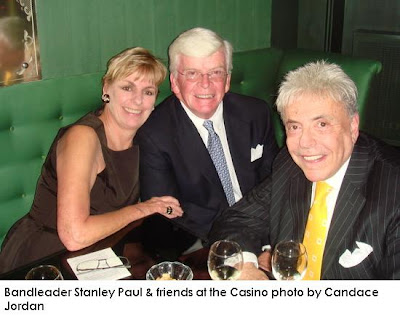
The nearby dining room has gleaming jade green & black walls & pillars, a shiny black floor and, black-glass tabletops. Against a mirrored wall, a faceted Art Deco glass fountain in the shape of an obelisk glows from within, and the whole room is lit with Empire style
torcheres. In a pair of twin dining rooms nearby, the walls are covered with pleated ivory fabric that gives the impression of classic fluting. A high elliptical bar room is finished in ivory enamel, nickel-plate & mirror, with hidden lights & sconces that reflect in the shiny black floor. Everything, everywhere, is shiny, and so impossibly elegant that you expect to see William Powell saunter around the corner at any moment, holding a platinum cigarette case & looking for a light.
You could send him down to the lower level, to what used to be a smoking lounge, where there is a suite of high-style black-&-red Regency furniture, tables in the form of military drums of about 1810, and where star-shaped bolts attach floor-to-ceiling panels of reverse-painted glass to the walls—glass for ease of cleaning, you know—except that, these days, you can’t smoke in Chicago. And there’s
more: card rooms & ante rooms & sitting rooms & bar rooms in a bewildering array of shapes & early-19th century styles, all perfectly executed & perfectly preserved and all of these rooms seem to open onto each other in so many possible ways—every room seems to have at least six sets of doors—that you begin to lose all sense of scale.
I’ve tried to draw a floor plan many times, and have failed every single time. It’s like a Chinese puzzle box, much bigger on the inside than it is on the outside. And that’s not all. The place is
invisible, or it seems to be. Only the right sort of people can see it. I can barely see it myself. I’ve had Chicago cabbies drop me off there & remarking “I know this neighborhood like the back of my hand, and ya know, I never noticed this place before.” The place is like that. It’s magic. Rue Carpenter was magic.

Photo by Edward Steichen for
VogueAnd the magic wasn’t just at the Casino, or just in Chicago. In 1930, she redecorated Elizabeth Arden’s salon in New York in black & silver & emerald green, with, of course, a ton of Directoire & Empire furniture. But here’s the fascinating great part: the furniture may have all been antique but the glittering effect is very New York 1930.
In Regency Redux, Emily used a full page photo that Edward Steichen took for Vogue magazine, a shot of two women on a sleek satin sofa in front of a wall-size mirror mounted with a chunky crystal sconce. That wasn’t a photo-studio set, but part of Rue’s décor for the Arden salon, and the sofa itself is a dead ringer for those that are still in use at the Casino. Anyway, that’s the good part about a style as distinctive as Rue Carpenter’s: there’s no mistaking her touch.
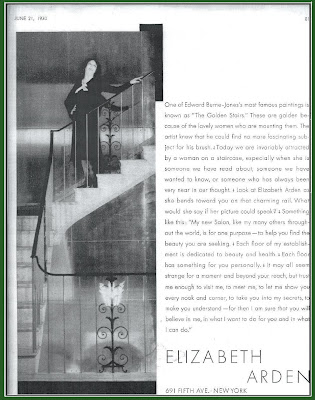
Tune in tomorrow when…
Rue Touches Emily
 "Charles Townley proudly displays his famous collection of ancient statuary in his gallery in this painting by Johann Zoffany. He is seated on a bergere while reading at a pembroke table."
"Charles Townley proudly displays his famous collection of ancient statuary in his gallery in this painting by Johann Zoffany. He is seated on a bergere while reading at a pembroke table."










